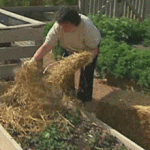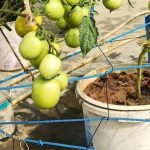Mulch doesn’t kill tomato plants. Alongside tomato plants, it is often used as a weed barrier. You shouldn’t use fresh mulch around your tomato plants until the temperatures have warmed up significantly.
Mulch is an important system in any gardener’s arsenal, but it’s important to use it correctly. Mulch can help suppress weeds, retain moisture, and keep your plants healthy. But if you use too much mulch, or put it on too thick, it can do more harm than good.
What Is Tomato Mulching and How Does It Help?
Mulching your tomatoes is simply covering the ground around the plants with a layer of material. This could be anything from black plastic to straws, wood chips, or even newspapers. The idea is to block out the sunlight so that weeds can’t grow, and to help retain moisture in the soil.
Tomato mulch also helps keep the fruit clean and free of dirt and other debris. And, as a bonus, it can help keep your plants warm in cold weather and cool in hot weather.
There are lots of tomato varieties that exponentially increase their growth by covering the ground around the plants with different colored mulching. Showing you some research about tomato mulch:
Total Fruit Yield (t ha-1)
| Mulch Material | Mulching Rate (t ha-1) | Mulching Rate (t ha-1) | Mulching Rate (t ha-1) | Mulching Rate (t ha-1) |
|---|---|---|---|---|
| 0 (No Mulch) | 5 t ha-1 mulch | 10 t ha-1 mulch | 15 t ha-1 mulch | |
| Rice Husk | 7.8 | 13.7 | 1.4 | 28.8 |
| Groundnut Shell | 9.3 | 9.2 | 13.4 | 23.2 |
| Dry Guinea Grass | 7.3 | 9.5 | 8.9 | 17.8 |
// The research shows that mulching rice husks helps to increase the fruit yield per ton per hectare. Additionally, dry guinea grass also responds positively to mulching practices. So, it’s proved that mulch has a beneficial effect on tomato production.

How many types of suitable tomato mulching are there?
As a gardener, you must know there are two types of tomato mulching- inorganic and organic.
Inorganic tomato mulches: black plastic, asphalt shingles, newspaper, and landscape fabrics.
Organic tomato mulches: straw, bark chips, leaves, pine needles, and grass clippings.
Black Plastic Mulches:
In cool climates, black plastic mulch is super effective. Because its dark black colour absorbs the heat and maintains the soil temperature properly. In the end, it helps to bloom faster, set fruits earlier, and increase the yield.
Asphalt Shingles Mulches:
It is made of granules of stone or mineral. This type of mulch helps to keep the soil moist by preventing evaporation. Many gardeners worry about the toxicity levels of shingles, and whether or not they are harmful to tomato plants.
However, this is usually unfounded – most of the time, water splashes from the shingles onto the garden will help dilute any toxic substances. So it won’t affect any toxicity on tomato plants.
Newspaper and Landscape Fabrics Mulches:
The newspaper is an organic material. Landscape fabrics are inorganic materials. Both of them help to prevent weeds by blocking out the sunlight. But landscape fabrics are more durable than newspapers. So it is a little bit costly.
Straw Mulches:
Straw is an organic material and it is one of the most popular mulches for tomato plants. It helps to keep the soil warm in cool weather and cool in hot weather. It also helps to retain moisture in the soil.
Bark Chips Mulches:
This reduces the evaporation of water from the soil and helps prevent weed growth, but it also protects your plants from harmful chemicals. Be sure to look for wood chips that are safe from dye before using them on your plants.
Grass Clippings:
Grass clippings can be used as a type of living mulch around your tomato plants. Be sure to use only grass that has not been treated with herbicides or chemicals, as these could harm your plants. Avoid “Bermuda grass” for covering the ground as it can be very invasive.
Which one is Perfect For tomato plants?
Before I am opinionated, let’s discuss comprehensive research on the mulching of tomato plants:
According to the research on tomato plants (Morphometric characteristics), They conducted different mulching films like green plastic, black plastic, silver/black plastic, white/black plastic film, yellow/brown plastic, rice straw mulching, etc.
As rice straw mulch can decrease the soil temperature by 3 degrees Celsius which eventually will lead to better growth of tomato plants in spring.
The table below displays the findings of our final report on the benefits of mulching tomato plants:
| Mulch Materials | Improvement (As per the Day After Transplanting (DAT) |
| Green and silver film mulch | 33 DAT at 34% Growth and increase in yield |
| Yellow and silver film mulch | 40 DAT the plants show improvements. |
| Rice Straw Mulch | 30 DAT, the plants show improvements. |
// In conclusion, the research indicates that various types of soil mulching materials have unique effects on the yield and quality of tomatoes. Therefore, rice straw mulch is perfect for tomato plants as it aids in better growth overall and is also organic.

Why Mulching Around Tomato Plants Is Important?
Mulching around tomato plants is important for several reasons, whether organic or inorganic, greatly influences tomato plant growth. Some of the key benefits of tomato mulching are-
Retain Soil Moisture
Mulching can retain up to 80 percent of the soil’s moisture by evaporation. This means less watering for you and healthier plants. Applying 2 to 4 inches of organic mulch on planting beds can achieve the following benefits.
Weed Suppression
Tomatoes need full sun to mature, so you’ll want to make sure they have plenty of room to grow by removing weeds. A thick layer of mulch will help prevent weed growth and save you time spent on your knees pulling them by hand.
Enrich Soil Aeration and Structure
As organic mulches decompose, they improve the structure of your soil by adding important nutrients and increasing drainage. This is especially beneficial in clay soils that can be dense and difficult for roots to penetrate.
Helps to Prevent fertilizer from Leaching
Yes, you need to fertilize your tomato plants, but you don’t want the nutrients to leach out of the soil before the plants can use them. A layer of mulch will help keep fertilizer in the root zone where it can be used by the plants.
How to use mulch without affecting tomato plants?
If you do decide to use mulch in your tomato garden, there are a few things to keep in mind to make sure it doesn’t harm your plants.
- First, don’t put the mulch directly against the stem of the plant. This can cause the stem to rot. Instead, apply a 2-inch layer of mulch around the plant, being careful to leave a space of about an inch between the mulch and the stem.
- Second, don’t use hay or straw as mulch. These can harbor weed seeds that will germinate and compete with your tomato plants for resources.
- Third, Don’t use weed-seeded mulches such as fresh grass clippings.
- Lastly, whenever you put mulch down, make sure to also pull the basal leaf off of any nearby plants. This will help to prevent the spread of diseases and pathogens.
How Much Tomato Mulch Do You Need?
The amount of tomato mulch you’ll need will depend on the size of your garden and the number of plants you have.
A general rule of thumb is to use about 2-3 inches (5-8 cm.) of mulch around each tomato plant. Be sure to pull the mulch back a bit from the stem of the plant to prevent rot.
When Should You Apply Tomato Mulch?
You can apply tomato mulch at any time, but it’s best to wait until after the soil has warmed up in the spring. This will give the plants a head start on the growing season.
However, you can add mulch right after transplanting the seedlings from the seedling trays.
In Conclusion,
I have been demonstrating the structural data that proves mulch will not kill tomato plants. Furthermore, it will help the plant in many perspectives. Thus it can be said that mulch is good for tomato plants.
My Thought: In my opinion, you should always use organic mulch in your garden. Not only will it add important nutrients to the soil, but it will also fulfill the general purpose of mulch, which is to protect your plants from extreme weather conditions and pests. I have been using and benefiting from it, and I hope you will do the same.
Ref: https://www.researchgate.net/publication/346652343_The_effect_of_different_mulching_on_tomato_development_and_yield

I am a graduate of Bangladesh Agricultural University, where I delved into various agricultural disciplines, equipping me with a profound understanding of agriculture. Beyond academics, I have hands-on experience in gardening and crop cultivation. My passion is to embrace sustainable farming and horticulture. With a BSc in Agriculture, I am dedicated to promoting environmentally conscious and efficient agrarian practices.
Bachelor of Science (BSc) in Agriculture (Hons.)
Master of Science. (Sustainable Agriculture & Food Security ) (MS)
Bangladesh Agricultural University




